| Article ID | Journal | Published Year | Pages | File Type |
|---|---|---|---|---|
| 3145006 | Journal of Dentistry | 2016 | 6 Pages |
ObjectivesThe aim of this study was to create prototype glass ionomer cements (GICs) incorporating a concentrated paste of chlorhexidine–hexametaphosphate (CHX–HMP), and to investigate the long-term release of soluble chlorhexidine and the mechanical properties of the cements. The purpose is the design of a glass ionomer with sustained anticaries efficacy.MethodsCHX–HMP paste was prepared by mixing equimolar solutions of chlorhexidine digluconate and sodium hexametaphosphate, adjusting ionic strength, decanting and centrifuging. CHX–HMP paste was incorporated into a commercial GIC in substitution for glass powder at 0.00, 0.17, 0.34, 0.85 and 1.70% by mass CHX–HMP. Soluble chlorhexidine release into artificial saliva was observed over 436 days using absorbance at 255 nm. Diametral tensile and compressive strength were measured after 7 days’ setting (37 °C, 100% humidity) and tensile strength after 436 days’ aging in artificial saliva. 0.34% CHX–HMP GICs were tested for their ability to inhibit growth of Streptococcus mutans in vitro.ResultsGICs supplemented with CHX–HMP exhibited a sustained dose-dependent release of soluble chlorhexidine. Diametral tensile strength of new specimens was unaffected up to and including 0.85% CHX–HMP, and individual values of tensile strength were unaffected by aging, but the proportion of CHX–HMP required to adversely affect tensile strength was lower after aging, at 0.34%. Compressive strength was adversely affected by CHX–HMP at substitutions of 0.85% CHX–HMP and above.ConclusionsSupplementing a GIC with CHX–HMP paste resulted in a cement which released soluble chlorhexidine for over 14 months in a dose dependent manner. 0.17% and 0.34% CHX–HMP did not adversely affect strength at baseline, and 0.17% CHX–HMP did not affect strength after aging. 0.34% CHX–HMP GICs inhibited growth of S. mutans at a mean distance of 2.34 mm from the specimen, whereas control (0%) GICs did not inhibit bacterial growth.Clinical SignificanceAlthough GICs release fluoride in vivo, there is inconclusive evidence regarding any clinical anticaries effect. In this study, GICs supplemented with a paste of chlorhexidine-hexametaphosphate (CHX–HMP) exhibited a sustained release of chlorhexidine over at least 14 months, and small additions of CHX–HMP did not adversely affect strength.
